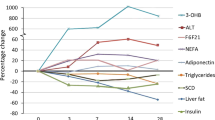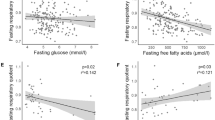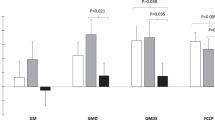Abstract
OBJECTIVE: To examine whether a certain increase in plasma free fatty acid (FFA) concentration leads to similar increases in lipid oxidation and energy expenditure in obese and lean men.
DESIGN: The study protocol consisted of a 30 min baseline period after which subjects received an i.v. bolus of 1000 IE heparin. Then consecutive infusions of 4.9, 9.8 and 19.6 μl/kg fat-free mass (FFM)·min of a lipid heparin mixture were started, each infusion for 30 min.
SUBJECTS: Eleven obese and 13 lean men with a mean body mass index (BMI) of 34.2±1.0 (±s.e.m.) and 23.9±0.5 kg/m2 and age 46.0±1.0 and 42.6±1.5 y, respectively.
MEASUREMENTS: Energy expenditure, respiratory exchange ratio (RER) and carbohydrate and lipid oxidation were continuously measured by indirect calorimetry. At the end of each infusion period, a blood sample was taken for FFA, glycerol, insulin, β-hydroxybutyrate, noradrenaline and adrenaline determination.
RESULTS: At baseline, plasma FFA levels were comparable in both groups. Lipid heparin infusion increased plasma FFA concentration by 301±47 μmol/l and 332±27 μmol/l in obese and lean men. Energy expenditure increased similarly in obese and lean men (0.34±0.08 vs 0.40±0.08 kJ/min, NS) during lipid heparin infusion, whereas RER decreased similarly in both groups. Lipid oxidation rates were comparable at baseline and increased similarly in obese and lean men (19±5 vs 13±4 mg/min, NS). Baseline plasma insulin levels were higher in the obese, but did not change during lipid heparin infusion. Plasma β-hydroxybutyrate concentrations were similar at baseline, but increased significantly less in the obese during lipid heparin infusion. Baseline noradrenaline and adrenaline concentrations did not differ significantly between groups. During lipid heparin infusion, plasma noradrenaline levels decreased significantly, but plasma adrenaline levels remained unchanged in both groups.
CONCLUSION: A certain increase in plasma FFA concentration leads to similar increases in lipid oxidation and energy expenditure in obese and lean men. The accumulation of fat in obese subjects may therefore be more likely to be due to a defect in adipose tissue lipolysis than a defect in lipid oxidation.
This is a preview of subscription content, access via your institution
Access options
Subscribe to this journal
Receive 12 print issues and online access
$259.00 per year
only $21.58 per issue
Buy this article
- Purchase on Springer Link
- Instant access to full article PDF
Prices may be subject to local taxes which are calculated during checkout


Similar content being viewed by others
References
De Jonge L, Garrel DR . Role of the autonomic nervous system in the thermogenic response to food in lean individuals Am J Physiol 1997 272: E775–780.
Astrup AV, Christensen NJ, Simonsen L, Bülow J . Effects of nutrient intake on sympathoadrenal activity and thermogenic mechanisms J Neurosci Meth 1990 34: 187–192.
Welle S . Sympathetic nervous system response to intake Am J Clin Nutr 1995 62: 1118S–1122S.
Thorne A, Wahren J . β-Adrenergic blockade does not influence the thermogenic response to a mixed meal in man Clin Physiol 1989 9: 321–332.
Astrup A, Simonsen L, Bülow J, Madsen J, Christensen NJ . Epinephrine mediates facultative carbohydrate-induced thermogenesis in human skeletal muscle Am J Physiol 1989 257: E340–E345.
Blaak EE, van Baak MA, Kempen KP, Saris WHM . Role of α- and β- adrenoceptors in sympathetically mediated thermogenesis Am J Physiol 1993 264: E11–E17.
Green CJ, Frazer RS, Underhill S, Maycock P, Fairhurst JA, Campbell IT . Metabolic effects of dobutamine in normal man Clin Sci 1992 82: 77–83.
Schiffelers SLH, Van Harmelen VJA, De Grauw HAJ, Saris WHM, Van Baak MA . Dobutamine as selective β1-adrenoceptor agonist in in vivo studies on human thermogenesis and lipid utilization J Appl Physiol 1999 87: 977–981.
Simonsen L, Stallknecht B, Bülow J . Contribution of skeletal muscle and adipose tissue to adrenaline-induced thermogenesis in man Int J Obes Relat Metab Disord 1993 17 (Suppl): S47–S51.
Blaak EE, van Baak MA, Kemerink GJ, Pakbiers MT, Heidendal GA, Saris WH . β-Adrenergic stimulation of energy expenditure and forearm skeletal muscle metabolism in lean and obese men Am J Physiol 1994 267: E306–315.
Liggett SB, Shah SD, Cryer PE . Characterization of β-adrenergic receptors of human skeletal muscle obtained by needle biopsy Am J Physiol 1988 254: E795–E798.
De Jonge L, Bray GA . The thermic effect of food and obesity: a critical review Obes Res 1997 5: 622–631.
Jung RT, Shetty PS, James WPT, Barrand M, Callingham M . Reduced thermogenesis in obesity Nature 1979 279: 322–323.
Blaak EE, van Baak MA, Kester AD, Saris WH . β-Adrenergically mediated thermogenic and heart rate responses: effect of obesity and weight loss Metabolism 1995 44: 520–524.
Colberg SR, Simoneau JA, Thaete FL, Kelley DE . Skeletal muscle utilization of free fatty acids in women with visceral obesity J Clin Invest 1995 95: 1846–1853.
Simoneau JA, Colberg SR, Thaete FL, Kelley DE . Skeletal muscle glycolytic and oxidative enzyme capacities are determinants of insulin sensitivity and muscle composition in obese women FASEB J 1995 9: 273–278.
Siri WE . The gross composition of the body Adv Biol Med Physiol 1956 4: 239–280.
Weir JB . New methods for calculating metabolic rate with special reference to protein metabolism J Physiol 1949 109: 1–9.
Ferrannini E . The theoretical bases of indirect calorimetry: a review Metabolism 1988 37: 287–301.
Moore JJ, Marcus M, Sax SM . Kinetic assay of β-hydroxybutyrate in plasma with COBAS BIO centrifugal analyzer Clin Chem 1982 73: 1334–1339.
Smedes F, Kraak JC, Poppe H . Simple and fast solvent extraction system for selective and quantitative isolation of adrenaline, noradrenaline and dopamine from plasma and urine J Chromatogr 1982 231: 25–39.
Ravussin E, Bogardus C . Relationship of genetics, age, and physical fitness to daily energy expenditure and fuel utilization Am J Clin Nutr 1989 49: 968–975.
Thiebaud D, Acheson K, Schutz Y, Felber JP, Golay A, DeFronzo RA et al. Stimulation of thermogenesis in men after combined glucose-long-chain triglyceride infusion Am J Clin Nutr 1983 37: 603–611.
Jung RT, Shetty PS, James WP . Heparin, free fatty acids and an increased metabolic demand for oxygen Postgrad Med J 1980 56: 330–332.
Kjekshus JK, Ellekjaer E, Rinde P . The effect of free fatty acids on oxygen consumption in man: the free fatty acid hypothesis Scand J Clin Lab Invest 1980 40: 63–70.
Kleiber H, Munger R, Jallut D, Tappy L, Felley C, Golay A et al. Interaction of lipid and carbohydrate metabolism after infusions of lipids or lipid lowering agents: lack of a direct relationship between free fatty acid concentrations and glucose disposal Diabetes Metab 1992 18: 84–90.
Golay A, Felber JP, Jallut D, Munger R, Ruiz J, Jéquier E . Effect of lipid oxidation on the regulation of glucose utilization in obese patients Acta Diabetol 1995 32: 44–48.
Schiffelers SLH, Brouwer EMC, Saris WHM, Van Baak MA . Inhibition of lipolysis reduces β1-Adrenoceptor mediated thermogenesis in man Metabolism 1998 47: 1462–1467.
Keller U, Gerber P, Stauffacher W . Fatty acid-independent inhibition of hepatic ketone body production by insulin in humans Am J Physiol 1988 254: E694–E699.
Schiffelers SLH, Van Baak MA, Saris WHM . β1-Adrenoceptor mediated thermogenesis in lean and obese men. (Abstract.) Int J Obes Relat Metab Disord 1997 21 (Suppl): S59.
Schiffelers SLH, Saris WHM, Van Baak MA . β2-adrenoceptor mediated lipolysis and fat oxidation are reduced in obese men. (Abstract.) Int J Obes Relat Metab Disord 1998 22 (Suppl): S75.
Acknowledgements
The authors wish to thank Joan Senden and Jos Stegen for their technical support during analysis of the blood samples. This study was supported by a grant from the Netherlands Organisation for Scientific Research (NWO), grant 903-39-138.
Author information
Authors and Affiliations
Corresponding author
Rights and permissions
About this article
Cite this article
Schiffelers, S., Saris, W. & van Baak, M. The effect of an increased free fatty acid concentration on thermogenesis and substrate oxidation in obese and lean men. Int J Obes 25, 33–38 (2001). https://doi.org/10.1038/sj.ijo.0801528
Received:
Revised:
Accepted:
Published:
Issue Date:
DOI: https://doi.org/10.1038/sj.ijo.0801528
Keywords
This article is cited by
-
Obesity-induced and weight-loss-induced physiological factors affecting weight regain
Nature Reviews Endocrinology (2023)
-
Free fatty acids, glicentin and glucose-dependent insulinotropic polypeptide as potential major determinants of fasting substrate oxidation
Scientific Reports (2021)
-
A novel clinical approach to evaluating changes in fat oxidation in healthy, overnight-fasted subjects
Translational Medicine Communications (2016)
-
The discovery of drugs for obesity, the metabolic effects of leptin and variable receptor pharmacology: perspectives from β3-adrenoceptor agonists
Naunyn-Schmiedeberg's Archives of Pharmacology (2008)
-
Impaired Fat‐induced Thermogenesis in Obese Subjects: The NUGENOB Study
Obesity (2007)



